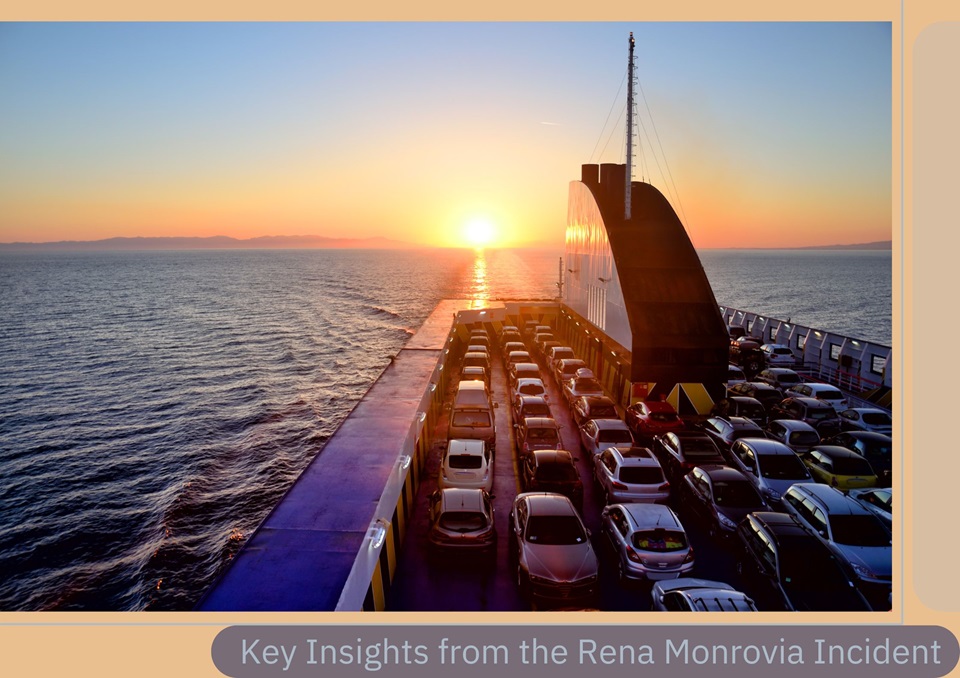
The Rena Monrovia was a Panamax container ship owned by the Greek shipping company Costamare Inc., known for its role in global trade. Originally built as ZIM America, the ship became part of a significant maritime incident in 2011 when it ran aground near Astrolabe Reef, leading to an oil spill and environmental damage. This incident serves as a critical reminder of the challenges and responsibilities in maritime operations, especially when transporting vehicles by ship.
Overview Of Rena Monrovia
Rena Monrovia was a Panamax container ship owned by the Greek shipping company Costamare Inc. through its subsidiary, Daina Shipping Co. Originally built as ZIM America for the Israeli company Zim, the ship has a significant maritime history marked by its operational changes and a notable incident that garnered international attention.
Rena Monrovia’s Specifications
| Specification | Details |
| Length | 236 meters (774 feet) |
| Breadth | 32.2 meters (106 feet) |
| Draught | 12 meters (39 feet) |
| Container Capacity | 3,351 TEU |
| Gross Tonnage | 38,788 |
| Net Tonnage | 16,454 |
| Deadweight Tonnage | 47,231 tonnes |
| Crew Size | 20 |
| Engine Type | Cegielski-Sulzer 8RTA76 |
| Engine Power | 21,996 kW (29,497 hp) |
| Fuel Consumption | 90 tons of heavy fuel oil/day |
| Service Speed | 21 knots (39 km/h; 24 mph) |
| Bow Thruster | Yes |
| Auxiliary Generators | Two 1,240 kW (1,660 hp) sets |
Rena Monrovia’s Shipping Services
Rena Monrovia provided significant maritime services as a Panamax container ship, facilitating global trade and transportation of goods. Its capacity to carry 3,351 TEUs made it an effective vessel for shipping companies, contributing to the efficiency of supply chains. However, the ship’s legacy is notably affected by the incident in 2011 when it ran aground near Astrolabe Reef, resulting in an oil spill and extensive environmental damage. This incident highlighted critical issues in navigational safety and the potential environmental impact of maritime operations.
Rena Monrovia When You Transport Something By Car: Cautions
When considering transporting cars by ship, the Rena Monrovia incident serves as a cautionary tale. Proper planning and awareness of potential issues are crucial for a successful shipping experience. Here’s a simplified guide to help you:
- Choose a Reputable Shipping Company: Research and select a well-reviewed shipping company experienced in car transportation. Verify their licensing, insurance, and shipping methods (Roll-on/Roll-off or container shipping) to find the best fit for your needs.
- Prepare Your Vehicle: Inspect the car for any existing damage and document it with photos. Remove personal items, check fluid levels, and ensure the battery and tires are in good condition.
- Understand Regulations and Insurance: Familiarize yourself with local and international regulations, including customs requirements for the destination country. Ensure you have adequate insurance coverage for potential damage or loss during transit.
- Final Steps Before Shipping: Drop off your vehicle at the designated terminal, complete all necessary documentation, and allow the shipping company to inspect and load the car securely.
- Arrival and Inspection: After transit, pick up your vehicle at the destination port and conduct a thorough inspection for any damage.
By following these steps and considering the lessons learned from Rena Monrovia, you can ensure a safer and more efficient car transportation experience by ship.
Lessons Learned From The Rena Monrovia Incident
The grounding of the Rena Monrovia near Astrolabe Reef teaches us important lessons for the shipping industry. First, it shows how vital accurate navigation is; shipping companies should focus on training their crews to use navigation tools correctly. The incident also highlights the need for strong plans to handle environmental emergencies like oil spills. Regular maintenance checks on ships are crucial to avoid mechanical problems, and thorough risk assessments can help identify dangers related to specific routes and weather. Good communication among all parties involved, along with following international maritime rules, is essential for reducing risks. By learning from this incident, the shipping industry can improve safety, protect the environment, and operate more sustainably.
Conclusion
In conclusion, the story of Rena Monrovia highlights the importance of careful planning and safety in maritime transport. By learning from its grounding incident, shipping companies can implement better navigational practices and emergency preparedness. When transporting cars by ship, following thorough guidelines and being aware of potential risks can lead to safer and more efficient shipping experiences. Ultimately, the lessons learned from Rena Monrovia can contribute to a more sustainable and responsible shipping industry.
FAQs
- What happened to the Rena Monrovia?
In October 2011, the Rena Monrovia ran aground near Astrolabe Reef in New Zealand, resulting in an oil spill and significant environmental damage.
- What lessons can be learned from the Rena Monrovia incident?
The incident emphasizes the importance of accurate navigation, proper crew training, effective emergency plans for environmental incidents, and regular ship maintenance.
- How can I ensure safe car transportation by ship?
To ensure safe car transportation, choose a reputable shipping company, prepare your vehicle properly, understand regulations and insurance requirements, and conduct a thorough inspection upon arrival.





